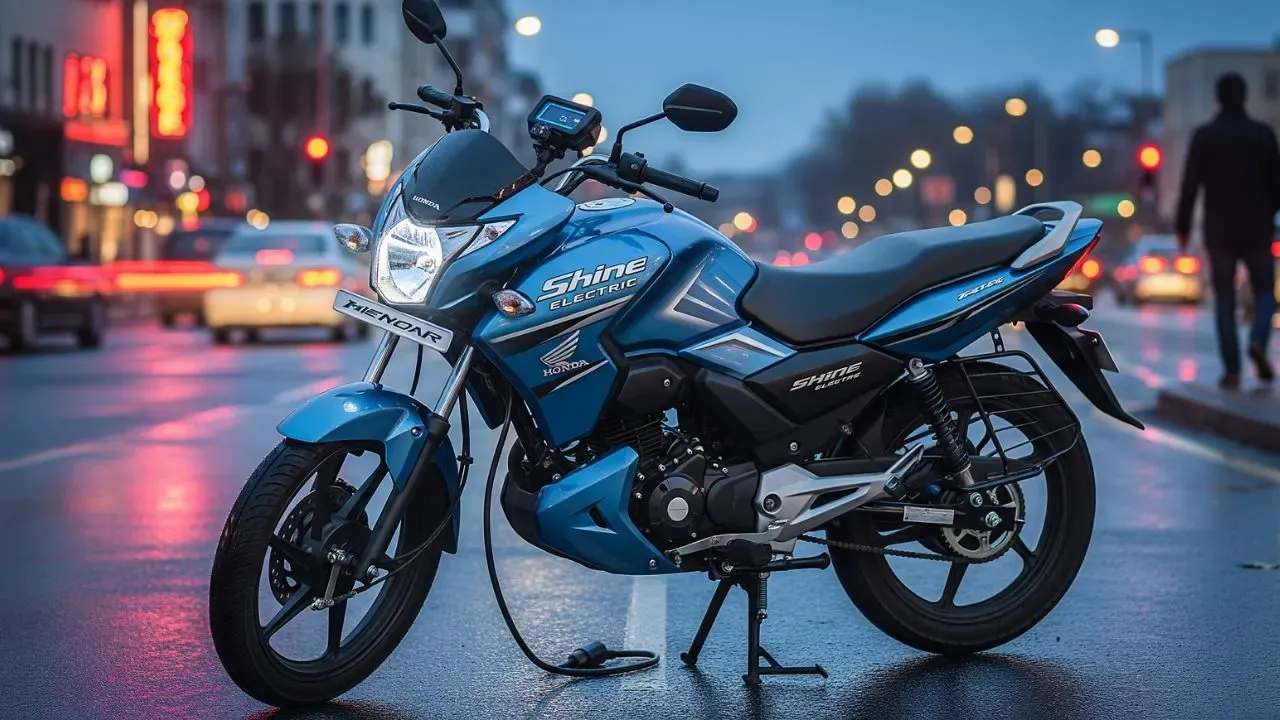Honda Shine Electric Launched – Recent patent applications reveal that Honda is developing an affordable electric motorcycle based on its popular Honda Shine 100 commuter bike. While the company has not made an official launch announcement, the detailed patent filings suggest a production-ready design that could potentially reach the market soon.
This electric version appears to use the same reliable chassis as the conventional Shine 100, with modifications to accommodate electric components. This approach helps keep development costs low, which could make the final product more affordable for Indian consumers.
The electric two-wheeler market in India is growing rapidly, with traditional manufacturers like TVS, Bajaj, and Hero now dominating sales. Honda’s entry into the electric motorcycle segment with a Shine-based model would mark an important step in expanding electric options beyond the electric scooters currently available.
Design and Build Quality of the Upcoming Honda Shine Electric 2025Honda Shine Electric
The patent images show that Honda plans to build its electric motorcycle around the existing Shine 100 chassis. This strategy offers multiple advantages, including cost savings that could make the final product more affordable, and faster development time since the platform is already proven and successful. The familiar Shine design is already well-known and trusted by Indian consumers.
Instead of the gasoline engine, the design features an electric motor positioned in the same area, using the existing mounting points. The visual appearance maintains the Shine’s recognizable silhouette with some electric-specific modifications. One of the most practical design elements is the inclusion of two removable battery packs located on either side of the frame where the engine would traditionally be.
Battery Technology and Swapping System
The Honda Shine electric motorcycle is designed with two removable lithium-ion battery packs. Each battery unit weighs 10.2 kg. This makes them easy to carry inside your home or office for charging. This removable design solves a big problem for city riders who may not have their own parking or charging spot.
Key features of the battery system include:
- Two removable lithium-ion battery packs for flexible charging
- Manageable 10.2 kg weight per battery for easy portability
- A smart cooling passage between the batteries for better performance
- An electronic control unit (ECU) positioned directly behind the batteries
Honda will likely use the same battery standard made for its Activa electric scooter. This would allow riders to use the growing number of Honda battery swapping stations across India.
Expected Performance and Riding Experience
While official specifications are not yet available, the patent details and industry analysis provide clues about the expected performance. The motor appears to be a compact, centrally mounted unit similar to those found on electric commuter bikes, likely in the 5-6 kW power range. This would likely translate to a top speed around 80-90 km/h, making it suitable for city commuting and suburban roads where high-speed highway performance is less critical.
The bike is being developed as a practical commuter vehicle rather than a high-performance machine. The focus is on providing adequate power for daily transportation needs while maximizing efficiency and range for the urban rider. The use of the proven Shine chassis suggests the handling and riding position will be familiar and comfortable for those already acquainted with the conventional Shine model.
Honda’s Electric Vision and Market Potential
Honda’s potential entry into the affordable electric motorcycle segment comes at a crucial time for the Indian market. The electric two-wheeler industry is transitioning from startup-driven to established manufacturer dominance, with legacy players like TVS, Bajaj, and Hero now accounting for more than half of all electric two-wheeler sales. Honda’s extensive dealership network and strong brand reputation could give it a significant advantage if it decides to enter production.
The company has already begun building supporting infrastructure, particularly through battery swapping stations for its electric scooter. This existing investment could easily be expanded to support an electric motorcycle, providing an important advantage over competitors. With Honda’s global commitment to electrify its lineup and phase out internal combustion engines by the 2040s, products like the Shine electric motorcycle represent important steps toward that goal.
When to Expect the Honda Shine Electric Motorcycle
As of now, Honda has not announced an official launch date for the Honda Shine electric motorcycle. However, industry observers suggest that because the bike uses an existing platform that has already sold over 300,000 units in India in 2023 alone, the development and production timeline could be relatively swift. Some reports indicate a potential launch sometime next year, though this remains speculative until Honda makes an official announcement.
The detailed nature of the patent applications suggests that the design is well beyond the concept stage and potentially ready for production once the company gives the final approval. The business case for such a vehicle appears strong, given the growing electric vehicle adoption in India and Honda’s need to compete in the electric two-wheeler space.
Conclusion on Honda’s Electric Motorcycle Development
The potential development of a Honda Shine electric motorcycle represents an exciting development for India’s evolving electric vehicle market. By leveraging the trusted Shine platform and incorporating practical features like removable batteries, Honda could create an appealing option for riders looking to transition from conventional gasoline-powered bikes to electric mobility.
While detailed specifications, pricing, and availability information will need to wait for an official product announcement, the patent filings reveal a serious effort by Honda to develop an affordable, practical electric motorcycle tailored to the needs of Indian commuters.
As the electric two-wheeler market continues to grow and evolve, having established manufacturers like Honda enter the electric motorcycle segment could significantly accelerate adoption and provide consumers with more reliable, well-supported options.
Must Read :- KTM Electric Bicycle 2025 Launched with 220KM Range at ₹1,499!
